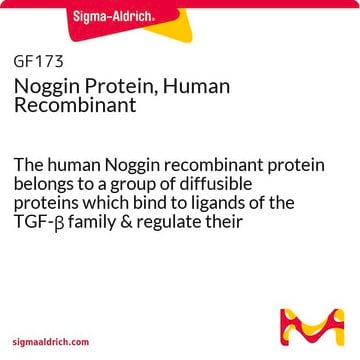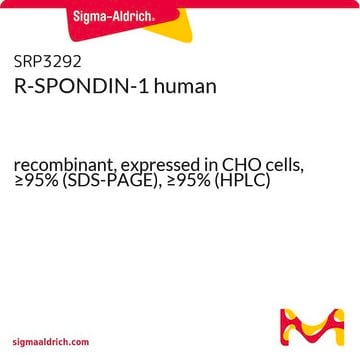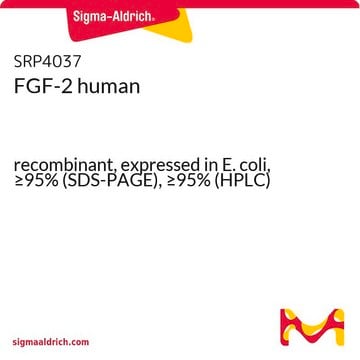H6416
Noggin human
recombinant, expressed in HEK 293 cells, HumanKine®, suitable for cell culture
About This Item
Produits recommandés
Source biologique
human
Produit recombinant
expressed in HEK 293 cells
Essai
≥95% (SDS-PAGE)
Forme
lyophilized powder
Puissance
≤200 ng/mL ED50
Qualité
endotoxin tested
Poids mol.
dimer 65 kDa (glycosylated)
Conditionnement
pkg of 1 mg
pkg of 10 μg
pkg of 100 μg
Conditions de stockage
avoid repeated freeze/thaw cycles
Technique(s)
cell culture | mammalian: suitable
Impuretés
≤1 EU/mg
Numéro d'accès UniProt
Température de stockage
−20°C
Informations sur le gène
human ... NOGG(9241)
Vous recherchez des produits similaires ? Visite Guide de comparaison des produits
Description générale
Application
Actions biochimiques/physiologiques
Noggin has a high binding affinity to heparin and heparan sulfate proteoglycans at the cell surface. Heparan sulfate-bound Noggin remains active and capable of binding BMP4 at the plasma membrane. Noggin can also be competitively displaced by heparin when bound to cells that express heparan sulfate proteoglycan.
Notes préparatoires
Remarque sur l'analyse
Informations légales
Code de la classe de stockage
13 - Non Combustible Solids
Classe de danger pour l'eau (WGK)
WGK 3
Point d'éclair (°F)
Not applicable
Point d'éclair (°C)
Not applicable
Faites votre choix parmi les versions les plus récentes :
Déjà en possession de ce produit ?
Retrouvez la documentation relative aux produits que vous avez récemment achetés dans la Bibliothèque de documents.
Les clients ont également consulté
Filtres actifs
Notre équipe de scientifiques dispose d'une expérience dans tous les secteurs de la recherche, notamment en sciences de la vie, science des matériaux, synthèse chimique, chromatographie, analyse et dans de nombreux autres domaines..
Contacter notre Service technique







![(S)-2-[[3,5-Bis(trifluoromethyl)phenyl]thioureido]-N-benzyl-N-3,3-trimethylbutanamide 97%](/deepweb/assets/sigmaaldrich/product/structures/373/888/118b46f2-6c2e-4a87-8266-c4dbcd5db51f/640/118b46f2-6c2e-4a87-8266-c4dbcd5db51f.png)





